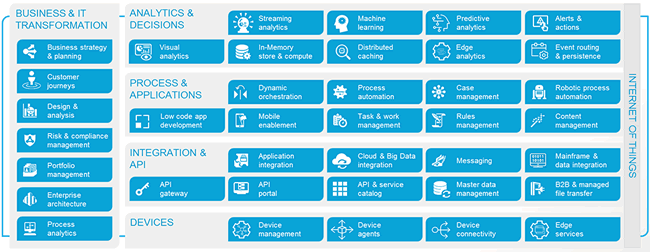Software AG, since 2017 the new owner of Cumulocity, announced a new version of the leading IoT platform which has been integrated in the Software AG portfolio and (re)launched as Cumulocity IoT – with several changes.
Cumulocity IoT also came out as the leader in the IoT platform market according to the MachNation AEP ScoreCard 2018.
Cumulocity has been a leading application enablement platform and IoT device management platform since its launch in 2010. Release 9 of the open Cumulocity IoT platform (announced end of February 2018), among others, comes with strengthened capabilities in the scope of edge computing.

Cumulocity IoT of course already had edge capabilities and was one of the platforms in the MachNation IoT Edge ScoreCard as previously reported in a post on Industry 4.0 and the IoT edge platform market. As mentioned, it also came out as the leader in the edition 2018 of the MachNation IoT platform ScoreCard (for Application Enablement Platforms, a.k.a. ‘real IoT platforms). It was the fourth year in a row that Cumulocity was rated as a leader in the Scorecard.
It’s interesting to see by the way how many IoT platforms from Germany, the native country of ‘Industrie 4.0’, are making waves in the market. On top of Software AG with Cumulocity IoT, also SAP (Leonardo IoT), Siemens (MindSphere), Bosch (Bosch IoT Suite) and relayr are ranking well in that IoT Edge ScoreCard, the AEP ScoreCard or both. Add a few others such as Ericsson and Telit and some leading vertical platforms and you have a market where the US and Europe are leading the pack.
Key changes in Cumulocity IoT R9: summary
On top of new edge extensions, Cumulocity IoT R9 also includes an open, enhanced Microservices SDK and industrialized lifecycle support for Microservices and DevOps. Add features supporting the IoT Platform-as-a-Service capabilities and enhanced LPWAN device integration and you have the major changes.
As Bernd Gross, Senior VP IoT and Cloud at Software AG (and since its early days CEO at Cumulocity) puts it in the announcement, stressing that the new Cumulocity IoT release is jam-packed with additional, new features: “We have included in this release numerous key features that support our new Microservices and IoT Platform-as-a-Service capabilities, including the ability to create dashboards automatically for individual or groups of devices with a full range of features and alerts. Also, we have significantly enhanced the Low Power WAN device integration with plug and play integration for Lightweight M2M, Narrowband IoT and LoRa devices.”
From Cumulocity to Cumulocity IoT
Cumulocity grew out of an innovation initiative within Nokia with the aim to make carrier-grade network systems applicable to the M2M market which back then was in full flux.
Already then it won several awards. When Nokia reorganized in 2012 Cumulocity was spun off from Nokia Siemens Networks with Bernd Gross as CEO. The company then continued to build the device-agnostic and network-agnostic application enablement platform it was known for. Early 2015 Frost & Sullivan granted Cumulocity the “2015 Global Frost & Sullivan Award for New Product Innovation” for its IoT-based platform for the discrete manufacturing market in the scope of the Frost & Sullivan analysis of the IoT asset management for discrete manufacturing market.
On top of the pure application enablement possibilities, other IoT platform features, such as device management, connectivity, real-time analytics, data visualization, storage and integration features were present. The company also had/has a strong partnerships ecosystem approach with a vertical take and its technology used in white-label versions (by telco’s such as NTT Communications, Telia, KPN, TELSTRA and Deutsche Telekom, which invested US$30m in IoT platform relayr in February 2018 via its Deutsche Telekom Capital Partner, who offer IoT solutions on top of the Cumulocity IoT technology; and by IIoT providers such as Bosch and Siemens, partners with their own Industrial IoT platforms).
Cumulocity, which counted over 100 enterprise customers and over 3,000 developers in 2017, was acquired by Software AG end March 2017 to strengthen Software AG’s Industrial IoT position. Software AG already was a strong player in industrial markets with its Apama Streaming Analytics Platform which was cited as a leader in September 2017 in The Forrester Wave: Streaming Analytics, Q3 2017, whereby among others its “deeper reach into Industrial IoT use cases, providing device management, digital twin and other connectivity-oriented services” was mentioned, referring to the acquisition of Cumulocity.
Cumulocity and Software AG already collaborated since 2015. In 2016 both announced a strategic IoT partnership whereby Cumulocity’s device connectivity and management solution was integrated in the Digital Business Platform of Software AG (under an OEM partnership). Software AG CTO Wolfram Jost at the time of that announcement: “This strategic OEM partnership combines Software AG’s strength in streaming analytics and integration along with Cumulocity’s device integration. It is now possible to bring together operational technology and integrate it with an enterprise’s IT systems (i.e., CRM, ERP, BI, etc) translating the streaming IoT data into meaningful, actionable information.”
Software AG’s launch of the new Cumulocity IoT platform
When Software AG acquired Cumulocity in March 2017 it was a logical next step and in the new ‘Cumulocity IoT’, which was announced in September 2017, the Apama Streaming Analytics Platform had replaced Cumulocity’s own streaming analytics engine.
On top of that it had added its Terracotta in-memory data management fabric and integrated workflow automation capabilities.
As the announcement at the occasion of the launch of Cumulocity IoT stated “The Cumulocity IoT portfolio includes a range of pre-packaged solutions such as condition monitoring, predictive maintenance and track & trace, as well as quick and easy device and sensor management, thus bringing the worlds of IT and operational technology (OT) together”. Cumulocity IoT was now part of Software AG’s Digital Business Platform (with all the capabilities of that modular platform depicted below).

So, in essence Cumulocity IoT combined capabilities of that Digital Business Platform and the original portfolio of products and solutions of Cumulocity. This includes the predictive capabilities which Software AG integrated after another acquisition in 2016, when it had bought artificial intelligence and machine learning software vendor Zementis in the scope of its IoT strategy.
This was mainly because of Zementis ADAPA (Adaptive Decision and Predictive Analytics), offering Software AG’s Digital Business Platform (Zementis is now integrated and also available as Zementis Predictive Analytics) what it needed in several IoT applications where AI and ML moved fast (e.g. self-driving cars, medical diagnosis, predictive maintenance and robotics). Just as was the case with Cumulocity, Software AG already had been working with Zementis since 2015.
The Cumulocity IoT Industrial IoT platform is available with cloud, hybrid, edge and on-premise deployment models, including the mentioned streaming and predictive analytics, strategic IoT scenario planning, in-memory data, adaptive application development, and enterprise architecture management, to name a few, as part of that modular platform approach.
This Cumulocity IoT modular approach enables companies to start quick within a limited scope and scale and add more features and sophistication as they grow (e.g. on the level of analytics, solution accelerators such as machine learning, workflow automation and enterprise & cloud integration).
More on Cumulocity and Cumulocity IoT Release 9
With Release 9 of Cumulocity IoT you can add those enhanced distributed architecture and edge processing capabilities which are mentioned in the announcement of the new version: new extensions delivering operational device autonomy, advanced local data processing, reduced data flows and improved response time with the ability for users to use the same dashboards, analytics models, integrations and apps when operating at the edge or in the cloud.
Among the edge extensions: “fast and secure industrial fieldbus connections, data forwarding filters, analytics distribution management and centralized edge platform management”.
In the context of IoT Microservices and DevOps Release 9 of Cumulocity IoT offers the mentioned open, enhanced Microservices SDK and industrialized lifecycle support for Microservices and DevOps, “enabling developers to create scalable SaaS apps for a microservices architecture using Docker containers, deployed in the cloud, or at the edge”, whereby the docker containers are fully isolated with resource quotas, centralized request authorization, tenant access, permission handling, and tenant associations.
The microservices-based apps, which are developed using Cumulocity IoT, can work on any deployment, scale elastically, are highly available and fault tolerant, and are easy to change, Software AG states.
Cumulocity IoT customers, on top of mentioned ones such as Deutsche Telekom and NTT Communications include Octo Telematics, Lyreco, Viessmann, Gardner Denver (among several other smart equipment makers and operators working with Cumulocity IoT), Dürr, Zeiss and Unlimit by Reliance Group.
All images belong to their respective mentioned owners.

